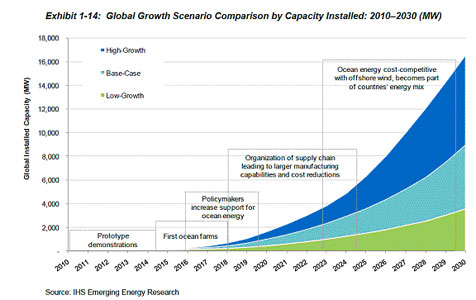Surge of prototype projects could signal dramatic growth in ocean energy industry
by Rona Fried, Ph.D.
Is the global ocean energy industry at a turning point? With all the attention focused on energy efficiency and smart grid, and with more mature renewable sectors like wind struggling, we haven’t heard much about ocean energy in the last year or two.
Financing is tight and venture capital is extra-cautious as the world struggles to get through this tough recession. It’s not the best time for a new industry to gain footing.
High initial costs and long development lead times makes the industry dependent on government support. Ocean energy has received much less support than solar or wind, but that could change. Costs are high because prototypes must stand up to ocean storms, and in the U.S. they must navigate a confusion of overlapping offshore permitting authorities.
After only a dozen wave and tidal prototypes were installed in 2009, more than 45 projects will have been tested in 2010 and 2011, according to IHS Emerging Energy Research. If these prototypes are successful, IHS believes the global ocean energy project pipeline is poised to begin scaling. They estimate that more than 1.8 GW of ocean projects in 16 countries are currently in the pipeline.

Could Ocean Energy be Problematic for Marine Life?
But concerns are surfacing that the electro-magnetic fields created by tide and wave generators (and the cables that bring their electricity to shore) could interfere with the natural guidance systems used by marine life.
Salmon, sharks, sea turtles, lobsters and crabs are among the marine life that use internal compasses that rely on the Earth’s magnetic fields. They travel thousand of miles each year using the earth’s magnetic fields to navigate. Ocean energy machines might also produce a low hum that could interfere with communication among whales. It’s long been known that the use of military sonar poses a deadly threat to whales, many of which have been found dead or dying following massive sonic blasts.
Research hasn’t been done on how these power devices affect the marine environment.
Promise for Energy Supply
The Northwest Power Planning Council estimates ocean energy could eventually supply 10% of US energy, with 50,000 MW off the Northwest coast, equal to the output of 50 nuclear plants.
Other sites under consideration are off the coast of Maine, Hawaii, Alaska, Florida and in the Mississippi River near Baton Rouge.
Thanks to government policy support, the UK holds the lead in ocean energy – 300 MW of projects are in the pipeline to be installed over the next five years. The UK wants to add 1.3 GW by 2020 to help meet its legally binding 2020 renewable targets. Ireland, France, Portugal, South Korea and Australia are also key ocean energy markets and will remain the industry’s primary focus for the next decade, according to IHS.
And it’s not just tiny, start-ups that are pushing the field forward. A slew of established energy firms, including leading European utilities and global technology suppliers with hydro and offshore wind experience, are interested in establishing leadership positions.
Of the various forms of ocean energy, tidal energy is poised to mature first because it offers the promise of predictable, lower-cost electricity and a standard design.
"The strong synergies between tidal turbine manufacturing and the hydropower industry have attracted major power sector OEMs," says IHS Senior Renewable Power Analyst Marianne Boust. "Over the past two years, all three of the major hydropower turbine vendors – Andritz Hydro, Alstom Hydro, and Voith Hydro – who account for over 80 percent of the global hydro turbine supply, have jumped into the tidal sector."
Because these large hydro players see tidal energy as a synergistic growth opportunity, they are crucial to catalyzing quick development and commercialization of the tidal industry. They could help the ocean energy industry overcome its technological challenges and drive down costs.
Key companies that are active in scaling Europe’s offshore wind industry are also eyeing ocean energy as they scale their renewable portfolios. Iberdrola-ScottishPower, Vattenfall, RWE and SSE all have a strong presence in offshore wind. Each is broadening to include ocean energy. A few have taken equity stakes in ocean technology firms, but most are funding project development through joint ventures.
Ocean Power Technologies Leads
The only pure-play publicly traded company in ocean energy is Ocean Power Technologies (OPTT), which is developing the first commercial scale wave energy system in the US off the coast of Oregon. The 1.5MW wave energy system, which will power about 1000 homes, is expected to be deployed in 2011.
In September, OPTT received $4.8 million in funding from the US Department of Energy, on top of $2 million it received in 2008. They are using the funds to construct the Oregon project and to develop its next generation 500kW system, which will have greater power extraction efficiency. The company is also focused on implementing a "Design-for-Manufacture" approach and reducing maintenance costs, to achieve lower installed capital and energy costs and make wave power more competitive with fossil fuels.
Also in September, OPTT connected a wave energy device to the US grid for the first time at the US Navy’s Marine Corps Base in Hawaii. The connection demonstrates the ability of wave systems to produce utility-grade, renewable energy that can be transmitted to the grid.
The Navy has supported Ocean Power’s technology development through its $15 million Littoral Expeditionary Autonomous PowerBuoy (LEAP) program. OPTT is providing an autonomous wave energy conversion system for the Navy’s near-coast anti-terrorism and maritime surveillance program.
OPTT is also working with Mitsui Engineering & Shipbuilding Co to apply its technology off the coast of Japan. In October 2009, a Japanese consortium signed a MOU to develop wave energy in Japan.
++++
The IHS study, Global Ocean Energy Markets and Strategies: 2010-2030, analyzes the various ocean technologies and companies and the potential size and timing for ocean energy scaling.

